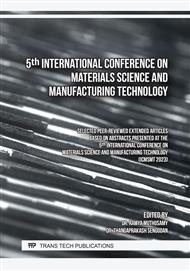p.111
p.125
p.137
p.149
p.161
p.171
p.185
p.197
p.205
Fractographical Characterization of Jute Fibre Reinforced Paper Composite Subjected to Drop Test
Abstract:
Plastic bags are one of the most widely used packaging materials in industries. Lower production cost, lightweight and high strength envisage its use in food packaging, carrier, and transportation industries. However, these plastic bags are non-biodegradable and cause serious water and soil pollution. It is one of the most thrust areas of research to overcome this problem in the current world. In the present investigation, fabrication, and characterization of an environmentally friendly and biodegradable "jute fibre reinforced paper composite" and "reinforcement free paper laminate" subjected to drop test were done. The standard procedure of the "MIL-STD-810G 516.6" drop test was followed. The adhesion between the matrix (paper) and reinforcement (jute fibre) was produced by applying a chemical-free adhesive made of flour and water. There were four different types of samples: single paper (SP), reinforcement-free paper laminate (RFPL), single-layer jute fibre reinforced paper composite (SLJPC), and double-layer jute fibre reinforcement paper composite (DLJPC). The microstructural characterization of the fractured surface after the drop was done using a scanning electron microscope operated at a voltage of 20 kV. The DLJPC samples had the maximum density and envisage drop-strength of 7 times as compared to the SP samples having the lowest density. The drop-strength exhibited linear regression with density for all the samples. The microstructure of the as-received matrix showed a non-homogeneous distribution of fibres along with micro-voids which were susceptible sites for the fracture. Unlike as-received matrix fibres distribution, the reinforcement fibres were aligned in two mutually perpendicular directions which leads to its strengthening. Hence, it can be said that the non-uniform structural properties envisaged by the as-received matrix can be compensated by uniformly distributed structural properties of the as-received reinforcement when both come together as a composite. The primary fracture mechanism of SP samples exhibited fibre breaking along with a few fibres' delamination. However, in the case of the RFPL sample, the nature of adhesion applied was capable to hold both the interfaces and the primary fracture mechanism was fibre breaking. It is suggested that the adhesive applied transmitted load through the interfaces. Unlike SP sample, the RFPL sample exhibited some adhesive pull-off. The fractured surface of the SLJPC sample showed that the matrix did not subject to fracture, however, reinforcement did fracture hence the load was transferred from matrix to reinforcement followed by a rupture of the reinforcement. Therefore, the primary fracture mechanism for the SLJPC sample was reinforcement rupture. The DLJPC sample showed a delamination of matrix and reinforcement.
Info:
Periodical:
Pages:
161-169
Citation:
Online since:
October 2023
Authors:
Keywords:
Price:
Сopyright:
© 2023 Trans Tech Publications Ltd. All Rights Reserved
Share:
Citation:



